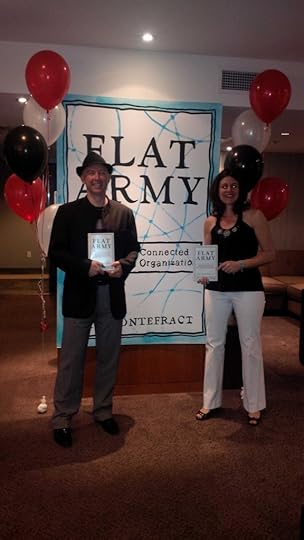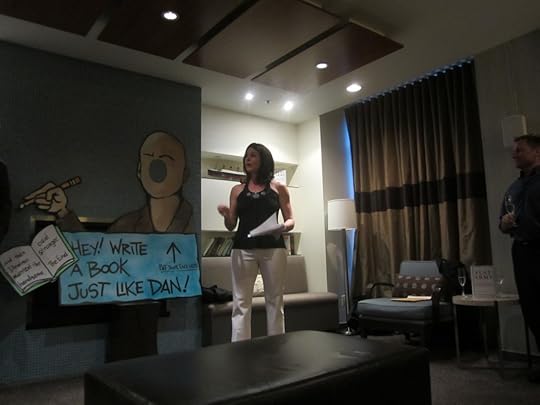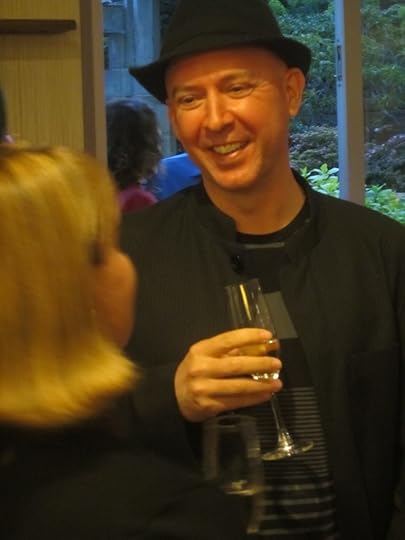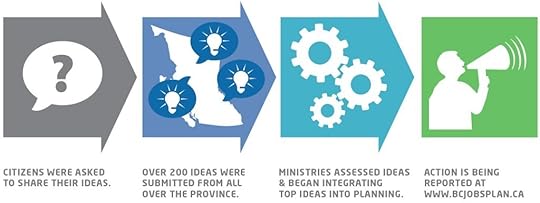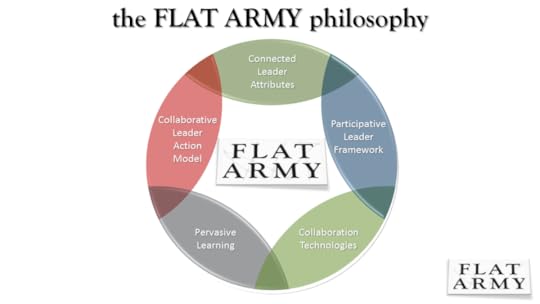Dan Pontefract's Blog, page 50
April 29, 2013
The Star Wars Mentoring Program
We could learn a thing or two from Star Wars.
Take for example what happens when you forget to brush your teeth, floss or use mouthwash. No one wants green slime oozing out of their mouth like Jabba the Hutt. I think some of it might have actually fallen on Princess Leia when she was shackled to Jabba’s throne while wearing what was the coolest bikini I had ever seen as a then 11-year old boy.
But I digress.
One aspect of Star Wars that goes relatively unnoticed is the galaxy-class mentoring program that is woven into the story arc.
No, I’m not kidding.
How do Jedi’s become a Jedi? It’s a masterful example of a mentoring program.
Anakin Skywalker had Obi-Wan Kenobi as his mentor while he was a young Padawan learning the ways of the Force. He then decided to lose his mind and get all evil — killing ‘younglings’ and ‘Sand People’ along the way — but he knew the power of a good mentor and so he cozied up to the evil Emperor (Darth Sidious) who became his go-to mentor as Anakin morphed into Darth Vader. (it’s a long story, you should watch the movies)
That’s a mentoring one-two punch story of excellence.
But the fact of the matter is Anakin had a mentor at all times.
Obi-Wan himself also had a mentor when he too was a Padawan learner. Qui-Gon Jinn provided guidance, counsel and insight as Obi-Wan learned the ways of the Jedi order.
And what about Luke Skywalker?
Not only did he have Obi-Wan as a mentor through his time on the tropical vacation planet of Tatooine, when he ventured off to everyone’s favourite swamp — Dagobah, a place even Shrek might say “no way am I living there” – Yoda chipped in with a very hands-on mentoring program as Luke fast-tracked his way toward the status of Jedi.
In summary, the manner in which George Lucas (Star Wars creator) instituted a mentoring program for the Jedi learners was masterful.
What does mentoring look like in your organization?
Do you personally have a mentor?
I like having three; a Millennial, a Gen X’er and a Baby Boomer otherwise known as my Padawan, my Jedi and my Yoda.
Related Posts:Virtual Worlds in an Organization are not a Time Waster (andFive Uses for Virtual Worlds in the WorkplaceWhose Your Brian Reid?Flat Army Book Launch Party … A Sea of HumanityI’m Not Scared of Email; I Developed a System called…
April 23, 2013
The Organization as a Cycling Peloton
As it turns out, cycling is beginning to take over North America as an extra-curricular athletic hobby.
According to the National Sporting Goods Association the number of Americans who ride bicycles is greater than all those who ski, golf, and play tennis combined. According to Outdoor Foundation there were 1.2 billion cycling outings in America in 2011 second only to jogging and running.
This got me thinking about one of my favourite personal passions (cycling) and our corporate organizations.
Maybe if we were to act like a peloton in our organizations, we might see higher levels of employee engagement.
In cycling speak, it’s what a pack of cyclists are called when they ride together. Check out the photo to the right for an example.
A peloton is a massive group of riders who ultimately work together — as a team — to move from one distance to another. Take away competitive cycling competitions for a moment (eg. Giro d’Italia or Tour de France) and think about amateur cyclists going out for weekend rides or events like the GranFondo between Vancouver and Whistler.
These women and men ride together as a team but what happens along the journey?
Sharing the load
Cyclists take turns at the front of the pack (ie. the peloton) to both set the pace and to protect others behind them from the wind. (A process known as drafting)
Those in front exert extra effort so others in the back can save some of their energy for their turn at the front at another interval in the ride
Proactive Communication
Often in a peloton, cyclists are proactively communicating with each other
If there is debris on the road, hand signals from whomever is in front alerts cyclists in the back to be careful
“On your right” or “stopping” are simple examples that cyclists shout out in the peloton to inform others of their intentions
“My turn to share the front” or “anyone need food or water” are other proactive examples of communication happening inside the peloton
Encouragement and Recognition
Whenever there are difficult impediments like tough gradients, sideways wind, pellets of rain, or even the successful maneuvering around unforeseen wildlife, cyclists from within the peloton are quick to recognize the effort or encourage the effort to continue
It really is a culture of encouragement inside the peloton
It would be nice if our organizations thought like and acted similar to a cycling peloton.
It sure might assist efforts to drive up employee engagement, creating a culture of sharing and connected leadership.
Related Posts:I Don’t Do GolfIt’s About Leadership: Ryder Hesjedal & the Giro…Ya, I Cry at Work. Do You?deets on tweets6 Use Cases for Enterprise Micro-Blogging
April 22, 2013
Flat Army Book Launch Party … A Sea of Humanity
It’s hard to think of myself as an author.
I mean for the entirety of my life, I’ve always known what I was … be it a son, brother, husband, dad, friend, educator, leader, Manchester United supporter, scotch drinker, Star Wars fan, pain in the ass, etc.
But I’ve never been a published author before.
I don’t have a playbook or a manual that I’m following either. I’m making it up as I go along.
The back cover of Flat Army is one of those examples. While I understand the industry typically defaults to having quotes from famous people waxing lyrical about the contents of said book, I refused and ultimately balked at this approach. My idea at first was to simply have a QR code that — after being scanned — would lead the reader to a video of me talking about the book.
That morphed into what is now on the back cover which is my own definitions of FLAT, ARMY and FLAT ARMY.
On Saturday, April 20 another of those ‘newbie author‘ items sprung into my alter persona. In the confines of a large party room overlooking False Creek in my adopted hometown of Vancouver, roughly 60 people gathered to celebrate the launch of the book. My beloved amongst a few close friends were the master planners; I was simply told to book off the night and not ask any questions leading up to the evening.
It’s amazing to me how powerful the human spirit really can be. The room was full of friendly and loving faces … each with a smile, a hug, a kiss and oodles of well wishes and congratulations for me.
Denise (my beloved) gave a speech that was not only breathtaking, it was amorous.
She read a beautiful poem my father wrote … penned in Stratford-upon-Avon, UK where he resides.
Dave (my artist friend) painted a larger than life-sized replica of the Flat Army cover alongside his usual touch of humour which came in the form of a giant-sized ‘stick your face in this hole and be an author like Dan’ placard.
I received not only a hangover the next day but a visceral reminder the sea of humanity that was in that room for a very special night is why I wrote the book in the first place. The pixels, letters and words in the book are a reflection of the people who have helped shape me into the person I am today. Although I’m affected by many people across this planet of ours, the book launch party and the chance to see so many people face-to-face was a reminder of how lucky I am.
Thanks to those that attended the party. Thanks to those that couldn’t attend. And thanks to everyone in my personal sea of humanity network that has helped shape me into the person I am today.
I am truly humbled. I am equally lucky.
Related Posts:Announcing the Full Book Cover Jacket of Flat ArmyWordle Graphic of Flat ArmyDid I Just Spam My Entire LinkedIn Network?The 10 Winners of Flat Army Copies Are …the second book
April 19, 2013
We Are All Boston
“The wind Daddy, it’s so cold,” says the 6 year-old boy at the park.
“Don’t worry Son,” replied the Dad. “I’ll get your jacket from the car.”
Boom.
“I’ll have an extra-hot double-shot latte please,” Jenny pleads to the barista as she struggles to pull herself together for the 7am start-time in her job.
“No trouble at all Ma’am,” the barista joyfully responds. “Coming right up.”
Boom.
Mark thinks to himself as he strolls down the sidewalk, “what time do I have to be at the gala tonight?” He notices and marvels at a hummingbird family approaching a beatific Trumpet Vine and continues his thought. “Oh right, it’s a 7:30pm start.”
Boom.
 Trees in the forest are much like humans on earth. For the most part, we humans crave sunshine, water, the accompaniment of others, a calming breeze against our face, and most of all, peace.
Trees in the forest are much like humans on earth. For the most part, we humans crave sunshine, water, the accompaniment of others, a calming breeze against our face, and most of all, peace.
The recent events in Boston, MIT and Watertown go against the wood grain of any tree in any forest in any land on any part of Earth. It’s as though the force of all evil manifested in an axe and our sturdy, trusty, peaceful forest was hacked down tree after tree after tree.
Deforestation of the human spirit – of the human soul – is deplorable, maleficent if not pernicious.
But the human spirit is akin to the trees in the forest. Strong. Resilient. Magnificent. There too is rebirth, regrowth and regeneration. There are forests among you. Rather sadly, there are those armed with the aforementioned axes willing and able to chop away. They want to see the ‘boom’. They are the axis of axes.
With set-your-watch consistency the forest will be there tomorrow. It’s your forest. It’s your life. You must own it. We must own it. Let us not leave it to kismet. Let us bleed courage as sap does from a tree.
Let us remember, We Are All Boston.
Related Posts:Flat Army DedicationEmail, A Love StoryCredo of the Collaboration CanoeWeb 3.0: It Should Be About Transferrable IdentityInterlocutors of 2012 (the goats are better for it)
April 16, 2013
An Example of the Flat Army CLAM in Action: BC Ideas2Action
I’m not a very political man.
You may even call me apolitical.
I always vote, but I often vote based on the issues versus being tied to a political party. I’m politically Neapolitan.
But that doesn’t mean I can’t tell you about a good story that involves Government, regardless of your or my political stripes.
In my home province of British Columbia, Canada, there has been a program in place now — called IDEAS2ACTION — where citizens have been asked to get involved, submit ideas and help shape opportunities for skills development across the entire province.
The process the Provincial Government followed is best summarized by the graphic found below:
There have been over 125 ideas submitted and vetted, with a fantastic accompanying dashboard that depicts the ideas (who they came from) and the action that has been taken by the Government.
There are some fantastic submissions such as:
Give Students More Exposure to the Trades in Earlier Grades
Encourage More Tradespeople to Become Teachers
Invest in Facilities and Equipment for K-12
These ideas are coupled by the actions that have since been taken by the Government.
This got me thinking about Chapter 8 of Flat Army: The Collaborative Leader Action Model which suggests the following:
Implementing Flat Army and the CLAM starts with the principal tenet that we need to open our doors, tear down the cubicles, and invite the entire organization to the table before making decisions or inventing the next new shiny object. Collaboration isn’t easy; in fact, it’s quite difficult. Through this chapter, please root yourself in the know-how that collaboration—as good as it is—always takes longer, but in the end, your leadership style, growth, team unity and organizational prosperity are better off .
The cyclical stages of the Collaborative Leader Action Model are as follows:
connect (with others)
consider (all options)
communicate (the decision and action plan)
create (the result)
confirm (the result met the target)
congratulate (through feedback and recognition)
My hat is tipped to Tanya Twynstra, Executive Director of Citizen Engagement in the British Columbia Government for spearheading the deployment of the CLAM in the province whilst (perhaps) not knowing that she actually was utilizing the CLAM itself. Tanya works for whatever Government is in power; she only looks out for the betterment of the province and its citizens.
In my opinion it’s a great story, regardless of your political affiliation. Mine included.
Visit the IDEAS2ACTION site for more information. It’s a good example of Government 2.0. (if you’re still into those 2.0 monikers)
Related Posts:Virtual Worlds in an Organization are not a Time Waster (andMy Network is my Net Worth – Part IIFlat Army Graphics on SlideshareFlat Army: Chapter 8 OverviewDon’t Be a FOOL: Fear of Open Leadership
April 15, 2013
Don’t Be a FOOL: Fear of Open Leadership
There are a lot of fools in our organizations today.
Why else is employee engagement at deplorable levels? Why else do we see senior leaders failing to adopt social collaborative technologies inside (or outside) the organization? Why else do we see authoritative, autocratic, fear mongering and controlling leaders still operating in vast numbers? Why do we see information and knowledge hoarding?
 It’s because the people who act this way are fools.
It’s because the people who act this way are fools.
They have a fear of open leadership.
They are the FOOL.
(It’s an acronym)
Work with me.
In my book Flat Army: Creating a Connected and Engaged Organization I define open leadership as follows:
“the act of engaging others to influence and execute a coordinated and harmonious conclusion”
There are some key words and phrases in my definition that FOOL’s don’t understand nor do they action.
1) engaging others
Engage with others? Why would a FOOL like me do that? The easier thing to do is to command others and to tell others specifically what to do and by when. I don’t have time to spare, I’m important you know.
2) influence
Influence? That takes too long and it requires me to slow down my assault on my next career move up the ladder. Forget influencing, I’m going to control everything about this employee, team and any objectives that are currently in flight. I’m a lot like tupperware; I control and prevent the contents from escaping.
3) coordinated
Coordinated? You mean, like, me and the team have to be on the same page? We have to coordinate our ideas, opportunities and actions before we get anything done? I’d rather stick my tongue on frozen monkey bars. That’s what I think of coordinating.
4) harmonious
Harmonious? I’m a FOOL; I can’t even spell harmonious let alone define it for you.
If you’re in an organization replete with FOOL’s — or worse — you have a direct leader who is a FOOL, you may want to rethink your current role and place of work.
If you are a FOOL, drop me a line. I’d be happy to chat about the book with you and get you operating in a flat, open manner.
Related Posts:10 Free Copies of Flat Army … Participate to Winthe FLAT ARMY cheat sheetAutotelic: The Word of 2013A Riddle, Wrapped in a Mystery, Inside an EnigmaThe Mysterium Tremendum Leader
April 13, 2013
Flat Army Graphics on Slideshare
Flat Army revolves around five key frameworks that leaders and organizations need to consider if they want to improve employee engagement and business results.
They are:
Connected Leader Attributes
Participative Leader Framework
Collaborative Leader Action Model
Pervasive Learning
Collaboration Technologies
Each of the five frameworks has an associated graphic that helps depict what they’re about.
I’ve made available a short presentation on Slideshare where each of those five frameworks and the corresponding graphics are available for you to review. (You can see it below as well)
What is a FLAT ARMY? from Dan Pontefract
Related Posts:flat army bookFlat Army: An Overview of the BookFlat Army: Chapter 4 OverviewFlat Army: Chapter 3 OverviewFlat Army: Chapter 7 Overview
April 8, 2013
Do You Surround Yourself With No?
 Far too often I come across stories or direct examples of a leader who has surrounded herself with the same general characteristics and behaviours of the leader herself.
Far too often I come across stories or direct examples of a leader who has surrounded herself with the same general characteristics and behaviours of the leader herself.
And not in a ‘geez, this beer tastes great’ way.
The trait I see that causes the most damage or stagnates a team and indirect teams into an endless pit of debate is the ‘no’ trait.
No, that will never work.
No, I don’t think we should pursue that.
No, it’s not something we would ever do.
These are lines a leader might say, but leaders are equally influenced by the team she is surrounded by and it’s highly likely she might be fed the ‘no’ ingredient well in advance.
It’s the ‘no’ seed planting approach. Some may call it sabotage.
A member of the team — who reports directly into the leader — is fully aware the leader is more apt to listen to the reasons why something shouldn’t be done (ie. the ‘no’) and therefore begins a proactive campaign of ‘no’ to help solidify the decision that the project should not move forward. Stakeholders from outside the team are blindsided, hurt and confused. Those external members trying to partner on the project thought things were going smoothly until the ‘no’ seed planting took shape and the leader (inevitably you might say) decried the opportunity was wrong. “No, we won’t proceed.”
If a leader is aware of her own personal tendency to say ‘no’ more often than ‘yes’ or heaven forbid ‘maybe’, might she think about hiring a team (or at least a few) who can think in the spectrum of ‘yes’?
I know, I know …
Related Posts:the FLAT ARMY cheat sheetThe Mysterium Tremendum LeaderFlat Army: Chapter 6 OverviewThe 4 Traits of a High Performing TeamNew Leadership Model: An Exercise in Bifurcation
the FLAT ARMY cheat sheet
Are you looking for a little insight into the 90,000 word version of my new book Flat Army: Creating a Connected and Engaged Organization? Perhaps a ‘try before you buy’ approach?
Fair enough.
Let me do my best and help you out in 559 words.
First off, Flat Army is aimed at three audiences:
Those in charge of the organization on the whole
Leaders with direct teams and/or teams of indirect teams
Individual contributors looking to make the leap into leadership
Second, it is a manifesto to change both the culture of your organization or team as well as the habits of leaders and teams. It aims to drive up overall employee engagement by connecting the dots between increased levels of collaboration, empowerment and participation coupled by new ways to lead, learn and share.
When employee engagement increases in your organization or team, when everyone feels as though they have both a say and an influential part to play in the objectives of the organization, productivity will increase and results will improve.
It’s a fact.
The book is broken down into seven sections:
Chapters 1, 2 and 3 are the setup. It discusses the horrific state of employee engagement, culture and command and control tactics on display in today’s organizations. It investigates why we got this way in the first place, and it outlines at a high level what we have to change in order to improve the health of our workplaces.
From there it’s a journey into the Flat Army philosophy aided by 5 key models.
Chapters 4, 5 and 6 revolves around the first of those 5 models; the Connected Leader Attributes. Think of a tree with its roots, trunk and branches. A Connected Leader is one who is becoming, being and going beyond through fifteen specific leadership attributes that will ensure you become a very engaging leader, helping your team and organization do the same along the way.
Chapter 7 surfaces what I call the Participative Leader Framework which requires leaders to employ the CARE principle (continuous, authentic, reciprocal and educating) as well as being able to both consume and contribute knowledge, ideas and content with the organization. This is coupled by the need to build out both your direct personal and professional network.
Chapter 8 is all about a daily leadership habit called the CLAM. It’s my belief that any Flat Army leader in today’s engaged organization must connect, consider, communicate, create, confirm and congratulate through all actions and initiatives.
Chapter 9 highlights the Pervasive Learning model. Quite simply, leadership and learning should always be thought of as part formal, informal and social and this chapter explains how to make it happen.
Chapter 10 cements the new Flat Army style of a leader and organization through Collaborative Technologies. Leaders need to converse, create content and provide context (the 3 C’s) to effectively become Flat.
The final and seventh component to the book (Chapters 11, 12 and the Afterword) details how each of the five models can be put into practice (individually, as a team and through the organization) such that everyone in the organization is singing from the same choir sheet, engaged and being a very productive member of the mission.
You can read Chapter 1 for free or if this has whetted your appetite enough, you can grab a copy of the book over here. (hardcover and ebook versions)
There is also a one-page Flat Army Cheat Sheet you may have interest downloading. (PDF)
Thanks for reading. Hopefully this was enough of a cheat sheet to get you somewhat interested.
Related Posts:Download Chapter 1 for Free – Flat Army: Creating a…Flat Army: Chapter 11 OverviewFlat Army: Chapter 10 OverviewFlat Army: Chapter 6 OverviewFlat Army: Chapter 5 Overview
April 4, 2013
Can Leaders Lead From the Side?
 According to ComScore, we are spending more and more time glued to a screen reading and collaborating on the Internet.
According to ComScore, we are spending more and more time glued to a screen reading and collaborating on the Internet.
No matter what country you live in, the digital golf cart has long left the clubhouse and it is gaining speed on the high-speed golf greens en route toward 100 percent pervasive participation.
What’s missing?
Dare I say a caddy?
Personally, I’d like to see far more senior executives and leaders gripping the social media (and by extension the social learning) 3-wood and driving participation balls as far as they can.
Enough of the putt-putt mini-golf shenanigans; just grip it and rip it.
By virtue of becoming more participative and thus collaborative with their internal and external social media presence, I reckon senior executives and leaders will begin to demonstrate “sideways leadership” in their organizations.
 Sideways leadership is like it sounds – leading horizontally and not just vertically. Social media cuts through hierarchy, or as Chairman Harold Jarche of Internet Time Alliance suggests, “hyperlinks subvert hierarchy, and networks subvert standardization.” To be an effective senior leader in any organization going forward, those who hold positions of high authority should begin to lead sideways and join the conversation as peers of the organization.
Sideways leadership is like it sounds – leading horizontally and not just vertically. Social media cuts through hierarchy, or as Chairman Harold Jarche of Internet Time Alliance suggests, “hyperlinks subvert hierarchy, and networks subvert standardization.” To be an effective senior leader in any organization going forward, those who hold positions of high authority should begin to lead sideways and join the conversation as peers of the organization.
Rest assured, everyone else in the organization not in positions of power will continue to respect your title, your experience and your authority. You need not worry about your amplitude; the mere fact you are participating in social media and thereby demonstrating sideways leadership will spread at the speed of a tee shot. Think about children who just found out there are free cookies at the back table of a second grade function. That’s how fast news will spread that you’re now a “sideways social media leader.”
At the Yammer corporate blog, author Maria Ogneva has found there to be significant benefits of social networks and social media within the organization, specifically as it relates to CEO priorities. McKinsey believes social media technologies are already in fact extending the organization.
But we’re not quite yet at the tee box, ready to yell “fore.”
In Too Big To Know, author David Weinberger states:
“Whether or not the Web tends to make us more insular, we know that human beings have a tendency toward homophily; we prefer to be with people who are like us. All the participants in this debate agree that excessive homophily is a bad thing.”
By extending this argument to senior leaders, I professionally argue that the reason we don’t yet see the internal or external social media participation uptake we yearn for is due to (at least in part) the natural crowd that has formed with senior leaders.
They have to unlearn what they’ve learned. As they spend most of their time with other senior leaders, who is going to break the homophilic cycle that prevents social media from crossing the chasm of increasing senior leadership sideways participation levels?
 Fast Company posits people and culture are the biggest barriers to digital transformation inclusive to the use of social media. Not surprisingly, if we don’t have senior leaders practicing sideways leadership through social media, that barrier is going to remain. Heck, we still have 44 percent of organizations blocking the actual use of social media at work.
Fast Company posits people and culture are the biggest barriers to digital transformation inclusive to the use of social media. Not surprisingly, if we don’t have senior leaders practicing sideways leadership through social media, that barrier is going to remain. Heck, we still have 44 percent of organizations blocking the actual use of social media at work.
In summary, we know that people (define as you will) are using the Internet more. I’ve got a hunch this isn’t going to suddenly nose dive or erratically stop. Employee habits, therefore, are changing. Not only are they using the Internet more, it is becoming a natural extension to the way in which business is conducted, how learning and communication occurs and how performance is achieved.
It’s time to introduce sideways leadership into the golf bag of all senior leaders.
Originally posted to CLO Blog. Reprinted with permission.
var _gaq = _gaq || [];
_gaq.push(['_setAccount', 'UA-12659981-1']);
_gaq.push(['_trackPageview']);
(function() {
var ga = document.createElement('script'); ga.type = 'text/javascript'; ga.async = true;
ga.src = ('https:' == document.location.protocol ? 'https://ssl' : 'http://www') + '.google-analytics.com/ga.js';
var s = document.getElementsByTagName('script')[0]; s.parentNode.insertBefore(ga, s);
})();
// ]]>
Related Posts:The 20% Leadership ChallengeWhere Does Leadership of Social Media Lie?Friday Fun: Get Back to WorkSocial Media is not Social LearningFriday Fun: Meet Gump Shun


